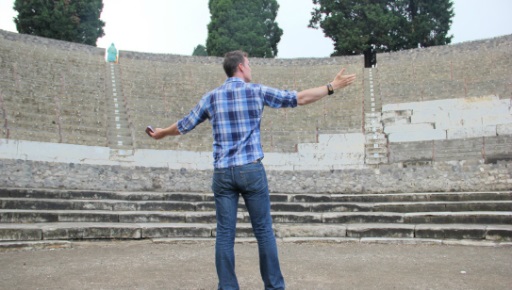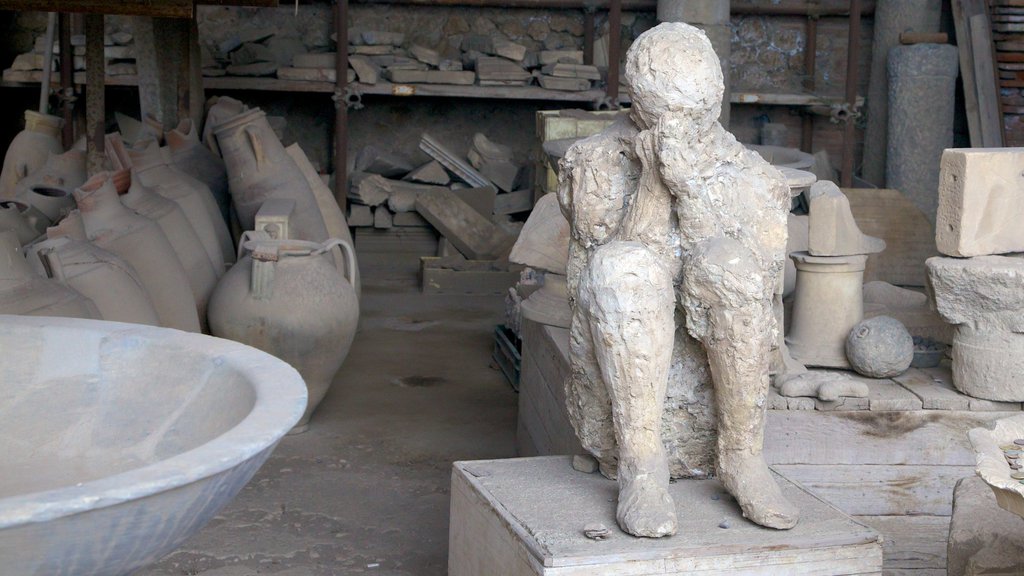
Exploring Pompeii with an awesome guide. All around us, tourists began to run for the exits. In the distance, a low grumble poured over the valley between us and Mount Vesuvius. As infrequent yet massive drops of water left craters in the dust at our feet, Pompeii emptied out. Our guide, Ilaria, showed no signs of panic. She told us that the storm would pass without hitting us.
She was completely engrossed in the columns at the end of the square. They framed a marble head of Zeus, which gleamed brilliant and white against the dark-gray shroud of the volcano in the background. A few steps closer to the altar and she stopped us. “This truly is my favorite spot in all the world.” She spoke with a hushed tone. The air around us thickened as another blast of thunder rolled down the valley and echoed through the walls of Pompeii—a city we had almost exclusively to ourselves at that moment, except for the plaster-coated bodies of those who died almost 2,000 years earlier.
“The volcano is still active, of course,” Ilaria told us. “It hasn’t erupted since 1944, but we always had the sirens growing up.”
Born in the shadow of Mount Vesuvius, Ilaria grew up with Pompeii as her backyard. As a child, she knew with characteristic certainty that she would become an archeologist. She had a little cut on her left hand from excavating that she wore like a wedding band to the ancient city. As she raised her right hand to make a sweeping gesture, you could catch the outline of Pompeii tattooed on the inside of her wrist. She wore a straw fedora with a bright candy swirl of colored fabric around it, and her eyes were framed with peacock-colored eye shadow. Guiding us through the perfectly preserved city streets, she pointed out ancient storefronts and community wells the way someone would point out their local coffee shop.
Viewfinder Tip: Be sure to stop on your way to Pompeii to try the local lemons that are famous along the Amalfi Coast.
When Mount Vesuvius snuffed the lights of Pompeii in AD 79, it was a quiet affair. The volcano didn’t spew fire and lava down on the city. A pyroclastic surge (a wave of hot air and toxic gas) rolled down from the volcano and cooked the inhabitants in a matter of seconds. Then, layer after layer of ash fell like thick snow and buried Pompeii in her freeze-frame. Loaves of bread at the local baker were preserved with the names of the citizens who ordered them still carved into the dough.
“This is how we now know so much of the daily lives of the people here,” Ilaria told us. “When it happened, so many people were just living their daily lives.”
Today, you can wander the streets of Pompeii and see every detail of ancient Rome, from an illustrated menu inside the port brothel to stone-carved directions to the local temple. Ilaria, who spent her life in Pompeii, saw details with some sort of super vision in a way we never could. Looking at her, you might think the city was still alive. She showed us houses of local families and told us about where they ate and their habits. She was giving us a tour of a powerful Roman port town. The fact that no one had lived there for 2,000 years seemed irrelevant.

As we rounded a corner into the theater, she asked me to stand on a tiny white square of marble in the center of the amphitheater. “Try saying something,” she suggested.
“What should I say?” When I asked the question, I heard my words come rushing back to me as if I was speaking into a microphone.
“They still hold concerts here,” Ilaria told us. “Because the acoustics are still perfect. Even after all this time.” She took us past the front row and then down a secret alley where we got to see the home of a wealthy man who trained gladiators.
“Unfortunately,” she told us, “gladiators didn’t have the Kit Harington body from Game of Thrones. Muscle heals much slower than fat. It was very common to keep your gladiators with a healthy layer of fat so that if they got cut, you could stitch them up without hurting any of their precious muscle.” We strolled past the dark rooms that the gladiators were kept in. “And they were short.” Ilaria made a little pouty face when she said this.
At the end of the tour, Ilaria called our attention to all the graffiti in town. It was mostly about which actor was the most handsome or which bakery sold the best bread. The ancient people of Pompeii wrote continuously on the walls around them. Later, when I checked my Facebook, I thought about how little had changed.
We went on many tours in Europe last spring; however, only one of them comes to mind the moment someone asks what Tawny and I have been up to. And it’s thanks to Ilaria, who did so much more than help pull Pompeii out of the past. She kept it alive.


